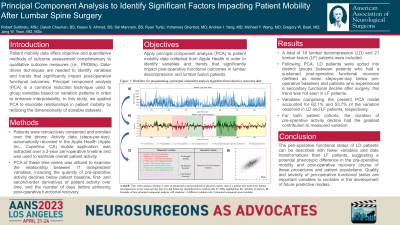Principal Component Analysis to Identify Significant Factors Impacting Patient Mobility After Lumbar Spine Surgery
Friday, April 21, 2023


Hasan S. Ahmad, BS
Medical Student
University of Pennsylvania
Philadelphia, Pennsylvania, United States
ePoster Presenter(s)
Introduction: Patient mobility data offers an objective and quantitative method of outcome assessment complimentary to qualitative outcome metrics such as patient-reported outcome measures. Data-driven techniques are needed to identify variables and trends that significantly impact post-operative functional outcomes. In this study, we applied principal component analysis (PCA) to reduce the dimensionality of patient mobility data and allow for easier identification and extraction of these relationships.
Methods: Patients were retroactively consented and enrolled. Activity data (steps-per-day) recorded in the Apple Health (Apple Inc., Cupertino, CA) mobile application was extracted over a 2-year peri-operative timeline. PCA of these time series was used to examine the relationship between 11 independent variables including the quantity of pre-operative activity declines below patient baseline, first- and second-order derivatives of patient activity over time, and the number of days before achieving post-operative functional recovery.
Results: A total of 18 lumbar decompression (LD) and 21 lumbar fusion (LF) patients were included. Following PCA, LD patients were sorted into distinct groups between patients who had a sustained post-operative functional recovery (defined as mean steps-per-day below pre-operative baseline) and patients who experienced a secondary functional decline after surgery; this trend was not seen in LF patients. Variables comprising the present PCA model accounted for 62.1% and 53.7% of the variation observed in LD and LF patients, respectively. For both patient cohorts, the length of pre-operative activity decline had the greatest contribution to measured variation.
Conclusion : The peri-operative functional status of LD patients can be described with fewer variables and data transformations than LF patients, suggesting a potential phenotypic difference in the pre-operative mobility and post-operative recovery course of these procedures and patient populations. Quality and severity of pre-operative functional status are important variables to consider in the development of future predictive models.
Methods: Patients were retroactively consented and enrolled. Activity data (steps-per-day) recorded in the Apple Health (Apple Inc., Cupertino, CA) mobile application was extracted over a 2-year peri-operative timeline. PCA of these time series was used to examine the relationship between 11 independent variables including the quantity of pre-operative activity declines below patient baseline, first- and second-order derivatives of patient activity over time, and the number of days before achieving post-operative functional recovery.
Results: A total of 18 lumbar decompression (LD) and 21 lumbar fusion (LF) patients were included. Following PCA, LD patients were sorted into distinct groups between patients who had a sustained post-operative functional recovery (defined as mean steps-per-day below pre-operative baseline) and patients who experienced a secondary functional decline after surgery; this trend was not seen in LF patients. Variables comprising the present PCA model accounted for 62.1% and 53.7% of the variation observed in LD and LF patients, respectively. For both patient cohorts, the length of pre-operative activity decline had the greatest contribution to measured variation.
Conclusion : The peri-operative functional status of LD patients can be described with fewer variables and data transformations than LF patients, suggesting a potential phenotypic difference in the pre-operative mobility and post-operative recovery course of these procedures and patient populations. Quality and severity of pre-operative functional status are important variables to consider in the development of future predictive models.
